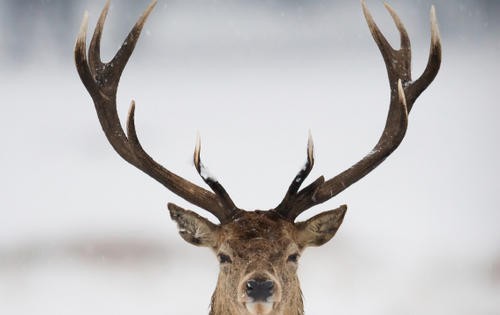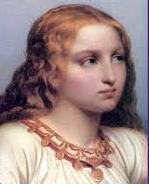
BRISINGSAMEN:
Freyja and her Necklace
by Peter Krüger
©2012
[Germanic Astronomy]
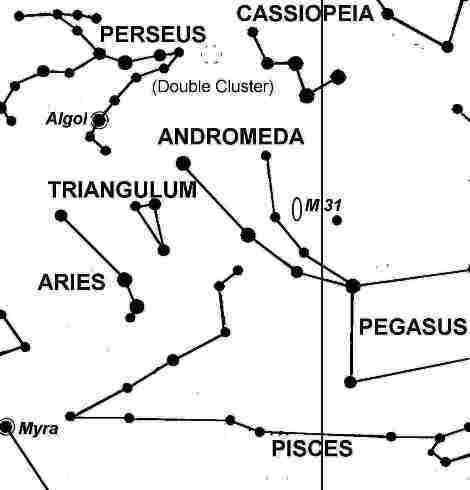 |
 |
In Norse mythology, Freyja is the daughter of the sea-god Njörd and closely associated with the sea, having spend some time there. In Gylfaginning 35, she is known as Mardöll (sea-shimmer) and her necklace Brisingamen is known as fagurt hafnýra, "the fair kidney of the sea", in a strophe of Ulf Uggason (Skáldskaparmál 23). The god Heimdall once wrestled Loki for possession of it, while both in the shape of seals.
The name Freyja simply means 'Lady', a name corresponding well to the Sumerian designation of this constellation: Inanna, meaning 'Lady of heaven'. The Akkadian name of this constellation is Anunitum with the similar meaning 'goddess of heaven'.
The constellation Andromeda stands in the sky above the constellation of Pisces, the Fishes. The two cords of the Fishes can be seen as reins in Freyja's hand as she drives her car, pulled by two cats represented by the circlets of the two fishes (alpha-Pisces).
I assume that the two circlets of stars have also been the inspiration for the two bright ornaments of the Brisingamen and Draupnir (for the western circlet). The Fishes have, by the way, also been brought into connection with Aphrodite/Venus and Eros/Cupid by the Greeks.
Interestingly directly next to this group are the stars of Aries that I interpret as the mane of the boar Gullinbursti (or Hildisvini), which Freyja is said to ride in the poem Hyndluljóð.
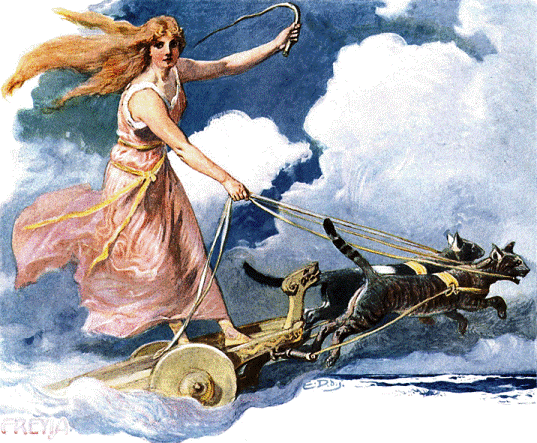 |
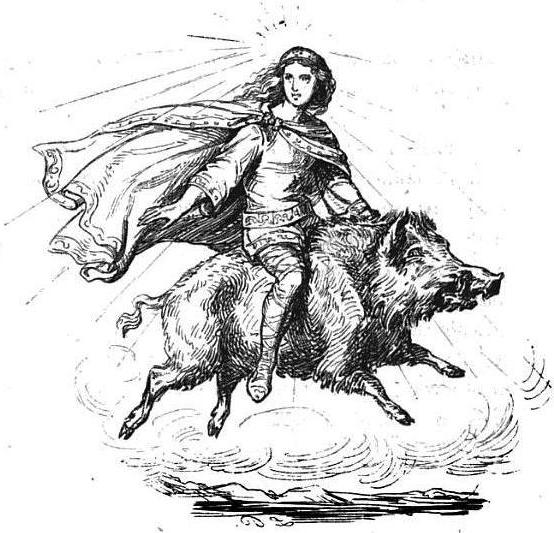 |
What about other Asynjur, e.g. Gefion, might they also have been connected to Andromeda? The main attribute of Gefion is a plough. In fact, one of the stars of today's Andromeda belongs to a constellation called 'the Plough'. It is the star gamma-Andromeda seen together with the three stars of Triangulum as MUL.(GISH).APIN, the plough. (Here, I follow the mainstream interpretation, e.g. van der Waerden).
This finding makes it even more probable that indeed Andromeda is the key to several stories around the Asynjur. Once again we find a connection to Sumerian constellations, showing how old these tales are.
We have seen that Draupnir is represented by the asterism of the Circlet of Pisces. The eight stars between Al-Rischa and the Circlet being the eight stars dropping out of Draupnir.
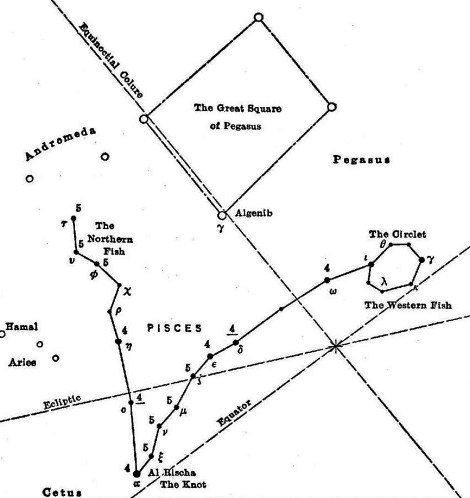 |
According to Gylfaginning the ring Draupnir was laid onto the pyre of Balder and reappears in the netherworld where Hermodr picks it up and brings it back to the gods. The ring burned with Balder is also mentioned in Skírnismál. I identified the (broken) ring in the netherworld with the semi circle of the Northern Crown, Corona Borealis, depicting also the broken brooch of Bödhild in Völundarkviða. Interestingly Corona Borealis is approximately rising at the time of the setting of the Circlet of Pisces.
This raises a thrilling question: if Corona Borealis represents a ring and the brooch of a maiden, does the Circlet also represent both a ring and a brooch or necklace? I'm referring to the famous necklace of Freyia, the Brisingamen. The name Brisingamen itself could provide an answer. According to Jacob Grimm the name goes back to the Middle High German verb "brisen", to pierce. If we look again on the star map of the western fish it could be described as a line of stars between Al-Risha and Fum al-Samakah piercing through the Circlet of Pisces — i.e. Brisingamen seen as a `pierced necklace, brooch'?
 |
||
| Al-Risha (Alrescha) |
β=Fum
al-Samakah |
|
There is also another fascinating possibility. What if the Brisingamen is not the Circlet of the western fish but shaped by the stars of the northern fish, reaching into the stars of Andromeda, seen since ancient times as a young maiden? The picture of a pierced jewel would fit again (although the stars of the northern fish do not show such a perfect ring as the western fish).
However, for this interpretation to be correct, we would also need an astronomical explanation why the Brisingamen is said to be forged by four dwarves in contrast to the two dwarfs forging Draupnir.
According to Sörla Þáttr, the ornament Brisingsmen was forged by the four dwarves Alfrigg, Dvalinn, Berlingr and Grerr. To get the ornament Freyia had to spend a night with each of the dwarves. The dwarves were said to live in a hollow stone.
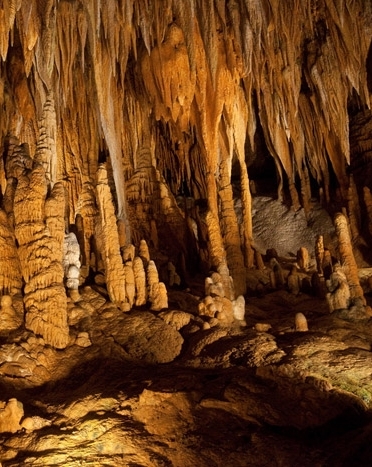 |
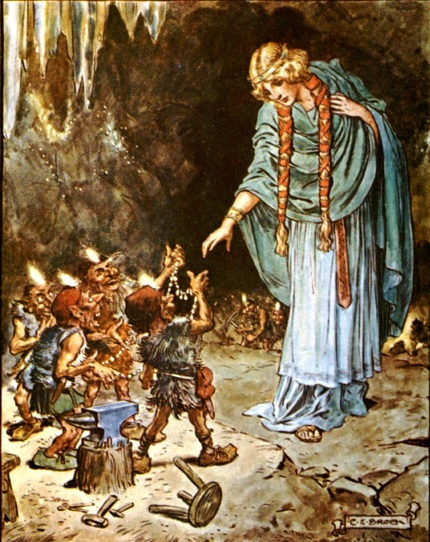 |
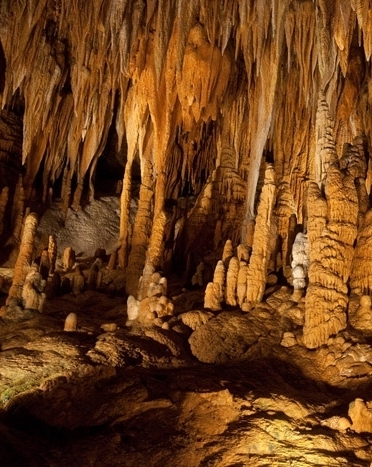 |
Looking on a star map it is not difficult to find the home of the four dwarves. Next to Pisces and Andromeda we find the asterism of the Pegasus square. Andromeda (Freyia) is so close to the asterism of the Pegasus square that the star Sirrah is seen as part of both of them. In the story of Loki's capture he was hiding in the shape of a salmon below a waterfall (Piscis Austrinus and the stream of water pouring out of the urn of Aquarius) and living in a house with four doors, clearly referring to the four equal sides of the Pegasus square. The square was also interpreted as the stone the dwarf Andvari (Formalhaut/Piscis Austrinus) was living in.
But where to find the four dwarves? We have seen that the constellation of Triangulum was both seen as a constellation called `the bellows' and also that the two brightest stars bore the names of dwarves: Sindri and Brokkr. I assume that we find the same system applied to the Pegasus square. It's seen as a constellation called `the hollow stone, the house, the holt and on the other side the four stars bear individual names: Alfrigg, Dvalinn, Berlingr and Grerr (the stars Alpha Andromedae [also known as Sirrah or Alpheratz], Scheat, Markab, Algenib).
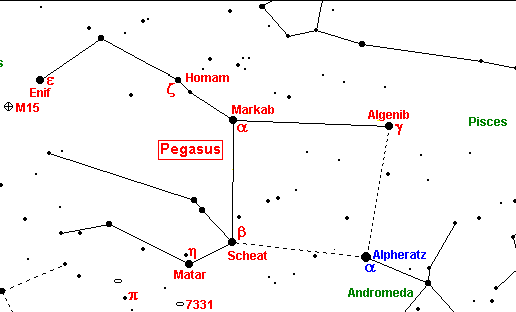 |
The dwarf Dvalin appears also in Grímnismál 33 as one of four stags. I assume that also the four stags can be brought into connection with the four stars of the Pegasus square, but that's another story.
